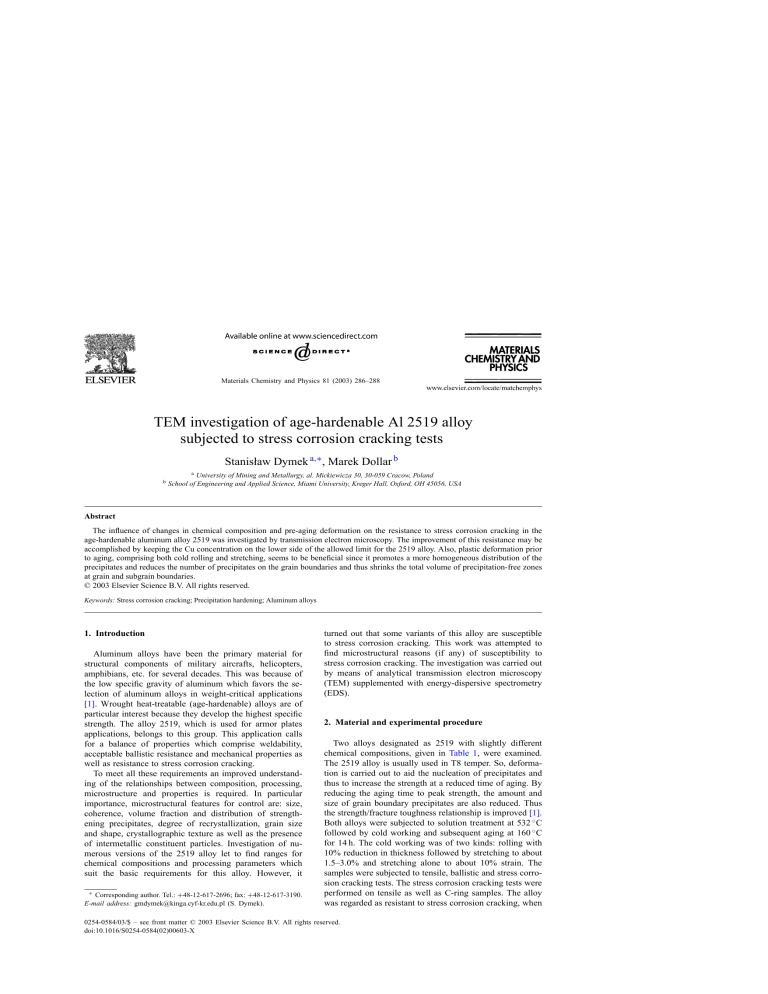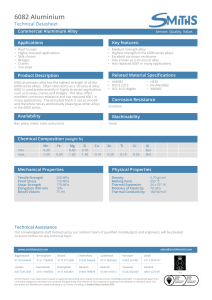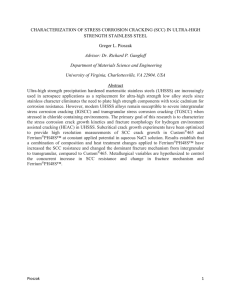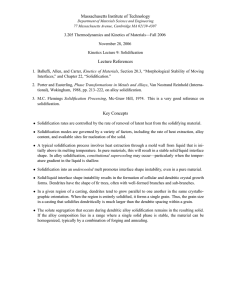
Materials Chemistry and Physics 81 (2003) 286–288
TEM investigation of age-hardenable Al 2519 alloy
subjected to stress corrosion cracking tests
Stanisław Dymek a,∗ , Marek Dollar b
b
a University of Mining and Metallurgy, al. Mickiewicza 30, 30-059 Cracow, Poland
School of Engineering and Applied Science, Miami University, Kreger Hall, Oxford, OH 45056, USA
Abstract
The influence of changes in chemical composition and pre-aging deformation on the resistance to stress corrosion cracking in the
age-hardenable aluminum alloy 2519 was investigated by transmission electron microscopy. The improvement of this resistance may be
accomplished by keeping the Cu concentration on the lower side of the allowed limit for the 2519 alloy. Also, plastic deformation prior
to aging, comprising both cold rolling and stretching, seems to be beneficial since it promotes a more homogeneous distribution of the
precipitates and reduces the number of precipitates on the grain boundaries and thus shrinks the total volume of precipitation-free zones
at grain and subgrain boundaries.
© 2003 Elsevier Science B.V. All rights reserved.
Keywords: Stress corrosion cracking; Precipitation hardening; Aluminum alloys
1. Introduction
Aluminum alloys have been the primary material for
structural components of military aircrafts, helicopters,
amphibians, etc. for several decades. This was because of
the low specific gravity of aluminum which favors the selection of aluminum alloys in weight-critical applications
[1]. Wrought heat-treatable (age-hardenable) alloys are of
particular interest because they develop the highest specific
strength. The alloy 2519, which is used for armor plates
applications, belongs to this group. This application calls
for a balance of properties which comprise weldability,
acceptable ballistic resistance and mechanical properties as
well as resistance to stress corrosion cracking.
To meet all these requirements an improved understanding of the relationships between composition, processing,
microstructure and properties is required. In particular
importance, microstructural features for control are: size,
coherence, volume fraction and distribution of strengthening precipitates, degree of recrystallization, grain size
and shape, crystallographic texture as well as the presence
of intermetallic constituent particles. Investigation of numerous versions of the 2519 alloy let to find ranges for
chemical compositions and processing parameters which
suit the basic requirements for this alloy. However, it
∗ Corresponding author. Tel.: +48-12-617-2696; fax: +48-12-617-3190.
E-mail address: gmdymek@kinga.cyf-kr.edu.pl (S. Dymek).
turned out that some variants of this alloy are susceptible
to stress corrosion cracking. This work was attempted to
find microstructural reasons (if any) of susceptibility to
stress corrosion cracking. The investigation was carried out
by means of analytical transmission electron microscopy
(TEM) supplemented with energy-dispersive spectrometry
(EDS).
2. Material and experimental procedure
Two alloys designated as 2519 with slightly different
chemical compositions, given in Table 1, were examined.
The 2519 alloy is usually used in T8 temper. So, deformation is carried out to aid the nucleation of precipitates and
thus to increase the strength at a reduced time of aging. By
reducing the aging time to peak strength, the amount and
size of grain boundary precipitates are also reduced. Thus
the strength/fracture toughness relationship is improved [1].
Both alloys were subjected to solution treatment at 532 ◦ C
followed by cold working and subsequent aging at 160 ◦ C
for 14 h. The cold working was of two kinds: rolling with
10% reduction in thickness followed by stretching to about
1.5–3.0% and stretching alone to about 10% strain. The
samples were subjected to tensile, ballistic and stress corrosion cracking tests. The stress corrosion cracking tests were
performed on tensile as well as C-ring samples. The alloy
was regarded as resistant to stress corrosion cracking, when
0254-0584/03/$ – see front matter © 2003 Elsevier Science B.V. All rights reserved.
doi:10.1016/S0254-0584(02)00603-X
S. Dymek, M. Dollar / Materials Chemistry and Physics 81 (2003) 286–288
287
Table 1
Chemical composition of the examined alloys (in wt.%)
Alloy
Cu
Mg
Zr
V
Mn
Zn
Fe
Si
1
2
5.56
5.80
0.36
0.23
0.11
0.10
0.07
0.07
0.44
0.43
0.02
0.02
0.14
0.12
0.04
0.04
three out of three tested specimens did not show evidence
of cracking.
The specimen for TEM investigation from tensile samples
were cut out from sections perpendicular to the tensile axis
while disks from the C-ring samples were cut out from the
section parallel to the lateral surface of the ring. The disks
were subsequently ground down to about 0.05–0.07 mm and
electropolished in a solution of 33% nitric acid in methanol
at a temperature of about −30 ◦ C and at a voltage of 30 V.
The TEM investigation was carried out using a Phillips CM
200 analytical scanning transmission electron microscope
operating at 200 kV. The structures were observed by conventional transmission or scanning modes while scanning
and/or nanoprobe modes were utilized for chemical analysis (EDS). The probe size for the scanning and nanoprobe
modes was approaching a few nanometers in diameter (practically 10–20 nm because at smaller electron probes the number of X-ray counts was usually too low for analysis). A
Cliff–Lorimer standard-less method for thin section was
used for a quantitative analysis. Standard-less methods always total selected elements to 100% which makes all results approximate since minor constituents are not taken into
consideration.
3. Results and discussion
Stress corrosion cracking may be defined as a phenomenon which results in brittle failure of alloys, normally
considered ductile, when they are exposed to a simultaneous action of surface tensile stress and corrosive environment, neither of which when operating separately could
cause damage [2]. Stress corrosion cracking in Al alloys
is characteristically intergranular [3]. However, the exact
mechanism responsible for stress corrosion cracking of a
susceptible aluminum alloy remains controversial in a particular environment. There are three main theories [4]: (1)
Anodic dissolution: this theory assumes that the cracking
is due to preferential corrosion along grain boundaries.
(2) Hydrogen-induced cracking: this theory postulates that
atomic hydrogen is absorbed and weakens the grain boundaries. (3) Rupture of the passive film. Since the role of grain
boundaries is essential in either case, the examination was
focused on the structure of grain and subgrain boundaries,
precipitates on grain boundaries, and changes in chemical
composition in regions near grain boundaries.
The Al 2519 alloy is a typical age-hardenable alloy which
is strengthened by the coherent θ phase which precipitates
Fig. 1. The hardening precipitates in the examined alloys.
as thin plates on {1 0 0} planes. The evidence of a uniform
distribution of this phase was found in the alloy (Fig. 1).
Regardless of differences in composition and applied deformation prior to aging, the alloys exhibited similar mechanical properties: the tensile strength was about 490 MPa
and the yield strength about 450 MPa, but alloy 1 exhibited
a higher elongation than alloy 2 (13 vs. 11%). All samples
passed ballistic tests, however, not all samples passed the
stress corrosion cracking tests. Alloy 2 failed all tests regardless of the mode of deformation prior the aging. On
the other hand, alloy 1 which was cold rolled and stretched
prior the aging passed all test while samples which were
only stretched failed.
The microstructures in all examined samples were similar, especially with regard to grain boundary precipitates, but
some differences between samples which passed and failed
the stress corrosion cracking tests could be detected. Samples of all variants exhibited precipitates on grain boundaries
and subgrain boundaries. These precipitates were usually
Cu-rich (probably semicoherent θ or incoherent θ (Al2 Cu)
phase). A feature of such a microstructure was the presence of precipitation-free zones along the grain boundaries
(Fig. 2). Such zones were also found in samples which
passed the tests. The Cu content within the precipitation-free
zones was lower than in the surrounding matrix and did not
Fig. 2. Precipitation-free zones at a grain boundary.
288
S. Dymek, M. Dollar / Materials Chemistry and Physics 81 (2003) 286–288
Fig. 3. Precipitates on a subboundary in alloy 2.
exceed 2 wt.%. According to the literature the difference in
electrochemical potentials of the Cu-depleted zone and the
Cu-rich matrix form a strong galvanic cell with a potential
difference of about 0.12 V [3]. The anodic Cu-depleted zone
is small in area compared with the area of the cathodic matrix, resulting in a high driving force for rapid intergranular
corrosion. Moreover, strain is likely to be concentrated in
the zones because they are relatively soft. It is believed that
the resistance to the stress corrosion cracking is inversely
proportional to the total volume of precipitation-free zones.
Some differences between the microstructures of samples
which failed and passed the stress corrosion cracking tests
were observed. However, these changes have not been correlated quantitatively with susceptibility. In samples which
failed the test, almost continuous chains of precipitates were
found on grain boundaries as well as subgrain boundaries
(Fig. 3). On the other hand, precipitates on grain boundaries
in samples which passed the test were distributed in a more
discrete manner. Cu-depleted zones were rarely found along
subgrain boundaries (or precipitation-free zones were very
narrow) in samples which passed the test. It is believed that
the more homogeneous distribution of Cu-rich precipitates
in such samples is due to the more complex deformation
mode (rolling and stretching) prior the aging. This produces
a more homogeneous dislocation substructure which provides more uniformly distributed potential nucleation sites
for the hardening precipitates. A larger number of huge
particles (well above 1 m) was found in samples which
failed the tests; the particles were often arranged in aligned
stringers. Such particles were always Fe- and Mn-rich (probably isomorphous with Al7 Cu2 Fe). Compounds containing
Fe are cathodic with respect to the Al matrix and promote
electrochemical attack. The protective oxide film over them
is very thin and may be easily broken by stress. However,
the presence of Mn reduces the detrimental effect of Fe
and it is not very likely that such particles enhance the
susceptibility to stress corrosion cracking in an appreciable
manner.
All samples were fully recrystallized. Also a variety of
precipitates was found in grain boundaries and grain interiors of all samples. The distribution of these precipitates
was relatively uniform. Their size ranged between 0.2 and
0.5 m. The Cu-depleted zones were never found around
such particles. Other precipitates contained Zr and sporadically V. These precipitates were found on grain boundaries.
Their presence is beneficial since they control the recrystallization and grain size. It is believed that such particles do not
influence the stress corrosion cracking behavior in a considerable manner. Neither segregation nor Mg-rich precipitates
were found at grain boundaries. It means that the anticipated
role of Mg to modify the precipitation process of the hardenable phase, and thus resulting in a greater age-hardening
effect, came up to expectations.
4. Conclusions
1. Complex plastic deformation prior to aging, comprising
both cold rolling and stretching, rather than stretching
alone, is beneficial for the stress corrosion cracking resistance since it promotes a more homogeneous distribution
of the precipitates and reduces the number of precipitates
on grain boundaries.
2. Lowering the Cu concentration in the 2519 alloy improves the stress corrosion cracking resistance.
3. All examined samples, in both alloying variants, may be
susceptible to stress corrosion cracking due to Cu-rich
precipitates on grain boundaries and formation of Cudepleted zones adjacent to the boundaries.
Acknowledgements
We would like to thank McCook Metals for conducting
all tests and for providing the material for the present study.
References
[1] E.A. Starke Jr., J.T. Staley, Prog. Aerospace Sci. 32 (1996) 131.
[2] I.J. Polmear, Light Metals, Halsted Press, An Imprint of Wiley, New
York, 1996, p. 62.
[3] J.R. Davies, Corrosion of Aluminum and Aluminum Alloys, ASM
International, Materials Park, OH, 1999, p. 99.
[4] T.D. Burleigh, Corrosion 47 (1991) 89.


